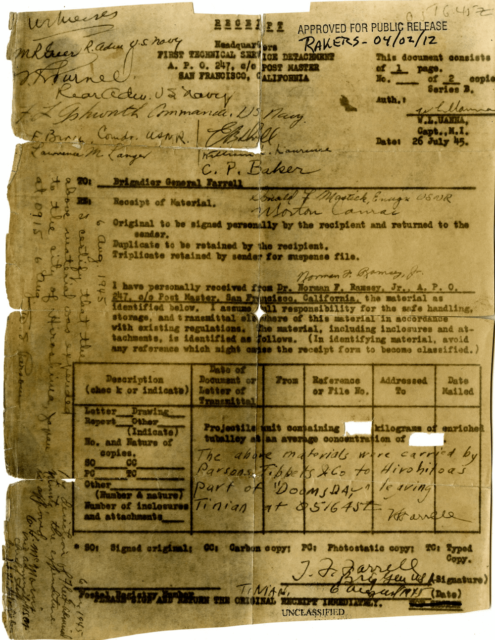One of history’s most significant receipts was that which marked the successful delivery and use of Little Boy, the atomic bomb dropped on Hiroshima during World War II. After billions of dollars and many years spent on research and development, the explosive was shipped across the Pacific and handed over to the American forces stationed on Tinian. The transfer resulted in the signing of the receipt, which might be the most terrifying, yet unique one ever drawn up.
Manhattan Project

In the late 1930s, European physicists sent a letter to US President Franklin D. Roosevelt, warning him about the atomic weapons research happening in Germany. At that point, the United States had been conducting its own research into the matter, but on a relatively smaller scale.
The intensity of the work happening in the US increased after Roosevelt received the Einstein–Szilárd letter and new information from intelligence services about the progress the Germans were making. In 1942, the Manhattan Project was launched, turning the ongoing atomic weapons research into a full-fledged military program.
While most famous for the development of the atomic bomb, the Manhattan Project encompassed enormous amounts of smaller programs tackling unique tasks. In fact, almost all of the project’s resources went toward the production of fissile material for the atomic bombs. In total, it cost just under $2 billion.
The Manhattan Project oversaw the development of two atomic bomb designs: the implosion-type, which used plutonium, and the gun-type, which involved uranium. Plutonium was easier to collect, but the implosion-type was much more complex. Given the bomb’s feasibility wasn’t trusted, it was the only type to be tested prior to use. That being said, the first completed gun-type atomic bomb, Little Boy, had used all of the project’s uranium-235, so there wasn’t enough for a test run.
The Trinity Test on July 16 1945 saw the first detonation of an atomic weapon and proved the implosion-type bomb worked. However, on the same day, Little Boy left the country onboard the USS Indianapolis (CA-35), headed for Tinian. Given how dangerous the cargo was, the transfer required a paper trail.
A receipt was drawn up for the Little Boy atomic bomb

One of the official pieces of documentation for the delivery of Little Boy is a tattered receipt, perhaps one of the most unique in history. It was signed by Thomas Ferrell, the Deputy Director of the Manhattan Project, to confirm the successful handover of much of Little Boy‘s components from Dr. Norman F. Ramsey.
Ramsey left the US onboard the USS Indianapolis, which made the journey across the Pacific Ocean in just 10 days. After arriving in Tinian, Ramsey signed over Little Boy to Ferrell. However, the receipt wasn’t just proof of the delivery of the atomic bomb – it also confirmed its use.
Regardless of Hiroshima‘s destruction, bureaucratic procedure required a piece of paper to confirm the use of the atomic bomb. To confirm this, Fleet Adm. Chester Nimitz‘s Chief of Staff signed the receipt, writing, “By direction of Fleet Admiral Nimitz, the expenditure of this item is approved.”
Another signature on the receipt is that of William S. Parsons, the weaponeer onboard Enola Gay, the Boeing B-29 Superfortress that dropped Little Boy. He wrote, “I certify that the above materials was expended to the city of Hiroshima, Japan at 0915 6 Aug.”
More from us: Wait for Me, Daddy: The True Story Behind the Iconic World War II Photo
Want War History Online‘s content sent directly to your inbox? Sign up for our newsletter here!
After it was signed, Ferrell kept hold of the atomic bomb’s receipt and had crew members on Tinian sign it. For the rest of his life, he kept the historical document in his wallet, and it’s now the only example of its kind known to exist. The receipt was donated to the US Army Heritage and Education Center in Carlisle, Pennsylvania by Ferrell’s family, where it remains today.
